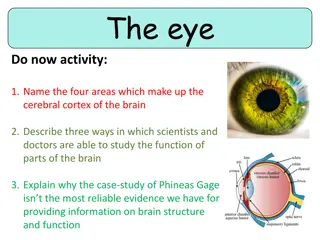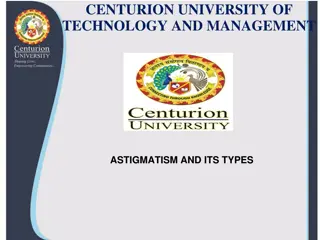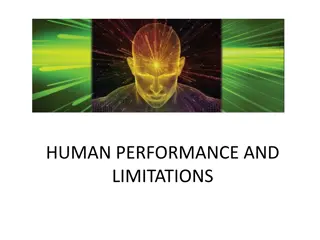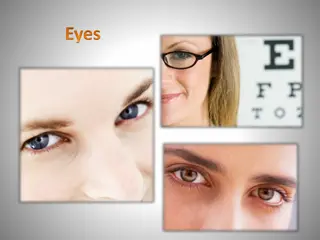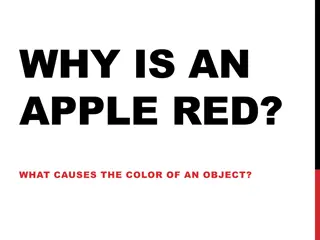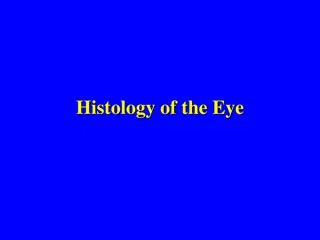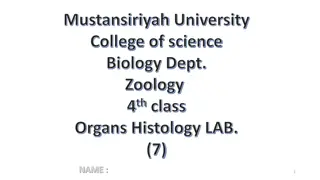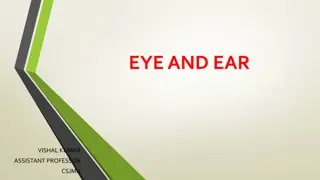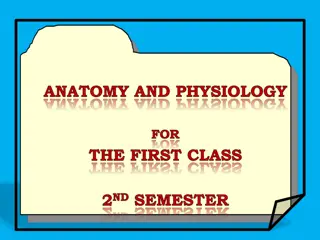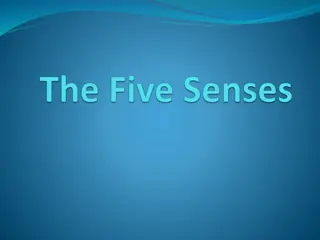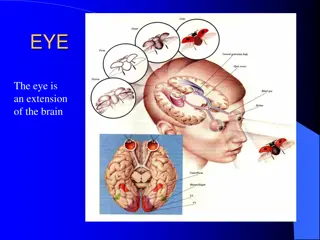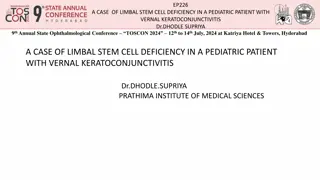The Anatomy and Function of the Eye
This comprehensive health assessment explores the intricate structures of the eye including the sclera, cornea, iris, retina, and optic disc. It delves into the visual pathways, accessory structures like eyelids and lacrimal glands, and special considerations like age and ethnicity. The visuals prov
0 views • 39 slides
The Structures and Functions of the Eye
Explore the main structures of the eye including the iris, lens, cornea, retina, and more. Discover how these components work together to facilitate vision and light focusing. Engage in activities to enhance your knowledge of eye anatomy and function.
0 views • 20 slides
Astigmatism and Its Types
Astigmatism is a common refractive error where light entering the eye fails to focus on the retina, resulting in blurred vision. This condition is characterized by variations in the shape of the cornea or lens, leading to disturbances in vision. There are two types of astigmatism: regular and irregu
4 views • 33 slides
Human Vision and Eye Function
Human vision is essential for many tasks, especially in professions like aviation maintenance technicians. Proper lighting and eye protection are crucial for optimal vision. The eye functions like a camera, with components including the cornea, iris, lens, and retina. Each part plays a vital role in
1 views • 36 slides
Fascinating Insights into the Functioning of Eyes and Cameras
Explore the intriguing similarities between the working mechanisms of human eyes and cameras. From capturing images to processing them, discover how our eyes serve as the ultimate biological cameras, sending visual information to the brain for interpretation. Delve into the intricate components of t
0 views • 10 slides
Science of Color Perception
Objects appear colored due to selective reflection of light wavelengths - some are absorbed, and the rest are reflected. The eye's complex structure, including the cornea, iris, pupil, lens, and retina, plays a crucial role in perceiving color. Color blindness results from missing cone cells in the
0 views • 9 slides
Histology of the Eye: Structure and Function Overview
Explore the histology of the eye, covering the general structure and the microscopic details of the cornea and retina. Learn about the three coats of the eye bulb, including the fibrous, vascular, and neural tunics. Dive into the composition of the cornea, from its transparent and highly innervated
0 views • 24 slides
Anatomy and Histology of the Eye: A Comprehensive Study
An in-depth exploration of the anatomy and histology of the eye, covering structures such as the cornea, sclera, choroid, iris, and more. Detailed descriptions of each component, including layers, composition, and functions, are provided alongside accompanying images for visual reference.
0 views • 11 slides
The Human Eye: Structure and Function
The human eye is a remarkable optical system that functions like a camera, with components such as the cornea, lens, and retina working together to form images that are perceived and interpreted by the brain. The structure of the eye, including the cornea, iris, lens, and retina, plays a crucial rol
0 views • 7 slides
The Importance of Vision and Eye Structures in Human Anatomy
Vision plays a crucial role in human survival, with more than half of the sensory receptors in the body located in the eyes. This article discusses the anatomy of the eye, including the structures involved in vision such as the cornea, pupil, iris, and conjunctiva. It also covers the accessory struc
0 views • 21 slides
The Importance of Sight and the Anatomy of the Eye
Dive into the significance of the sense of sight, why it is crucial, and how the eye functions to process visual information. Discover the roles of different eye parts, such as the cornea, iris, retina, and optic nerve. Engage in experiments to understand how light affects the eyes and learn about t
0 views • 30 slides
Acute Visual Loss: Causes and Evaluation
Loss of vision can occur suddenly, affecting one or both eyes and various parts of the visual field. This guide explores the definition, pathophysiology, and evaluation of acute visual loss. Common causes include optic nerve diseases, retinal disorders, and vascular issues. The visual pathway from t
1 views • 37 slides
Ultrastructural Alterations of Renal Tissue in a Male Patient with Fabry's Disease
Fabry's disease is a rare X-linked lipid storage disorder characterized by deficient lysosomal alpha-galactosidase A activity. This condition primarily affects males, leading to chronic kidney disease and progression to end-stage renal disease. Kidney involvement is a critical aspect, and high doses
0 views • 24 slides
Advanced Gaze Estimation Techniques: A Comprehensive Overview
Explore advanced gaze estimation techniques such as Cross-Ratio based trackers, Geometric Models of the Eye, Model-based Gaze Estimation, and more. Learn about their pros and cons, from accurate 3D gaze direction to head pose invariance. Discover the significance of Glint, Pupil, Iris, Sclera, and C
0 views • 40 slides
The Intricacies of the Human Eye and its Functions
Delve into the fascinating world of the human eye, an extension of the brain, as we explore its proximity to the optic nerve bundle and spinal cord. Understand the crucial role of the retina, lens, cornea, optic nerve, ciliary muscles, and suspensory ligaments in vision. Discover how the retina rece
0 views • 13 slides
Complex Ophthalmic Case Study at TOSCON 2024: Weill-Marchesani Syndrome and Ichthyosis Co-occurrence
A detailed case study presented at the 9th Annual State Ophthalmological Conference (TOSCON) in 2024, featuring a 35-year-old female patient with Weill-Marchesani Syndrome (WMS) and Ichthyosis. The rare combination of these genetic conditions poses unique challenges in ophthalmic management, with ma
0 views • 6 slides
Case Study: Limbal Stem Cell Deficiency in Pediatric Patient with Vernal Keratoconjunctivitis
Limbal stem cell deficiency (LSCD) is a rare condition characterized by inadequate corneal rejuvenation and conjunctivalization of the cornea. In this case study, a 14-year-old male with Vernal Keratoconjunctivitis presented with itching, eye rubbing, and corneal epithelial scarring resembling a who
0 views • 6 slides
Digital Image Processing Fundamentals
This content provides insights into the essential aspects of digital image processing, focusing on elements of visual perception, the structure of the eye, image formation, brightness adaptation, and discrimination. Explore how the human visual system, akin to a camera, processes visual information
63 views • 8 slides
Lenses and Vision Defects in Medical Physics
Explore the fascinating world of lenses and vision defects in this detailed lecture from Sabah Ibrahim Abbas at Al Karkh University. Discover the properties of convex and concave lenses, how light refraction forms images, and the workings of the human eye with its cornea, iris, lens, and retina. Gai
28 views • 29 slides
Structure and Function of the Eye: Overview
The structure and functions of the eye, including the iris, cornea, lens, and accommodation mechanisms are explained. Explore how your eye adjusts to light, focuses images, and perceives depth. Discover the similarities between the eye and a camera's mechanisms.
0 views • 20 slides

